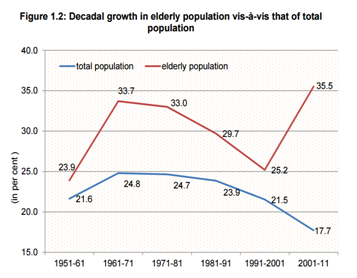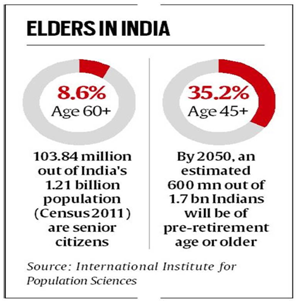Moving from population control policy to sustainable living
Context
India being at the third stage of the demographic transition, and experiencing a slowing growth rate due to constant low mortality and rapidly declining fertility, now is the time to focus on improving Human capital and sustainable living for the elderly.
Background
- The United Nations’ World Population Prospects (WPP), 2022, forecasts India becoming the most populous country by 2023, surpassing China, with a 140 crore population.
- This is four times the population India had at the time of Independence in 1947 (34 crore).
- Now, at the third stage of the demographic transition, and experiencing a slowing growth rate due to constant low mortality and rapidly declining fertility, India has 17.5% of the world’s population.
- As per the latest WPP, India will reach 150 crore by 2030 and 166 crore by 2050.
Analysis
What India has gained before?
- India reached a significant demographic milestone when its total fertility rate (TFR) slipped to (2)two, below the replacement level fertility (2.1 children per woman), as per the National Family Health Survey.
- However, even after reaching the replacement level of fertility, the population will continue to grow for three to four decades owing to the population momentum.
Factors contributing in unstable fertility rate
- High illiteracy levels
- Rampant child marriage
- High levels of under-five mortality rates
- A low workforce participation of women
- Low contraceptive usage compared to other States
What is the government’s strategy to control Population increase in India?
- National Population Policy 2000 —aims to bring the total fertility rate (TFR) to replacement level by 2010 and to achieve a stable population by 2045, at a level consistent with sustainable economic growth, social development, and environmental protection.
- It envisages achieving replacement-level TFR (about two children per woman) through “promotional and motivational measures” that emphasize quality of life, rather than through numerical targets for the use of specific contraceptive methods, which plagued previous programs.
- The policy talks of better management of public health, education, and sanitation, and focuses on women’s employment.
- Other goals are keeping girls in school longer, rising the age at which girls marry to 18 or 20, reducing infant and maternal mortality, and achieving universal immunization of children against vaccine-preventable diseases.

What is the present requirement to be focused?
- The focus of action should be on extensive investment in human capital, on older adults to live with dignity, and on healthy population ageing.
- We should be prepared with suitable infrastructure, conducive social welfare schemes and massive investment in quality education and health.

Impacts of demographic transition
- Economic factors: The deficits in the human capital development and policy failures, the demographic change itself is able to make substantial contribution to the economic changes in the country.
- Inter-state Migration: The demographic heterogeneity, is also leading to huge inter-state migration.
- There has been relatively large inflow of migrants from the northern belt having high fertility rate to the southern region with below replacement level of fertility particularly in unskilled occupation.
What are the concerns for India to achieve the sustainable population strategy?
- Male dominant sex-ratio in India: In 2011, the sex ratio was 943 females per 1,000 males; by 2022, it is expected to be approximately 950 females per 1,000 males.
- Improvement in sex ratio should be a priority as some communities face severe challenges from a marriage squeeze (an imbalance between the number of men and women available to marry in a specific society) and eventualbride purchase.
- Shift in Disease patterns: There has been a transition towards non-communicable diseases (NCDs), the cause of more than 62% of total deaths.
- Public health finances:India’s public health financing is low, varying between 1% and 1.5% of GDP, which is among the lowest percentages in the world.
- Increase in elderly population: The share of India’s elderly population is now increasing and is expected to be 12% by 2050. After 2050, the elderly population will increase sharply.
Conclusion
India’s demographic pattern generates a broad optimism but also strange paradoxes. Undoubtedly the higher population growth in some parts of the country is a matter of concern. It creates unbalanced economic growth pattern and recent experiences show large migration patterns.
Therefore, further enhancement of demographic advantage depends upon the faster demographic changes in these states. At the same time, the demographic changes provide other major challenges to the nation. It is important that the government and the people at large to pledge for future challenges.





